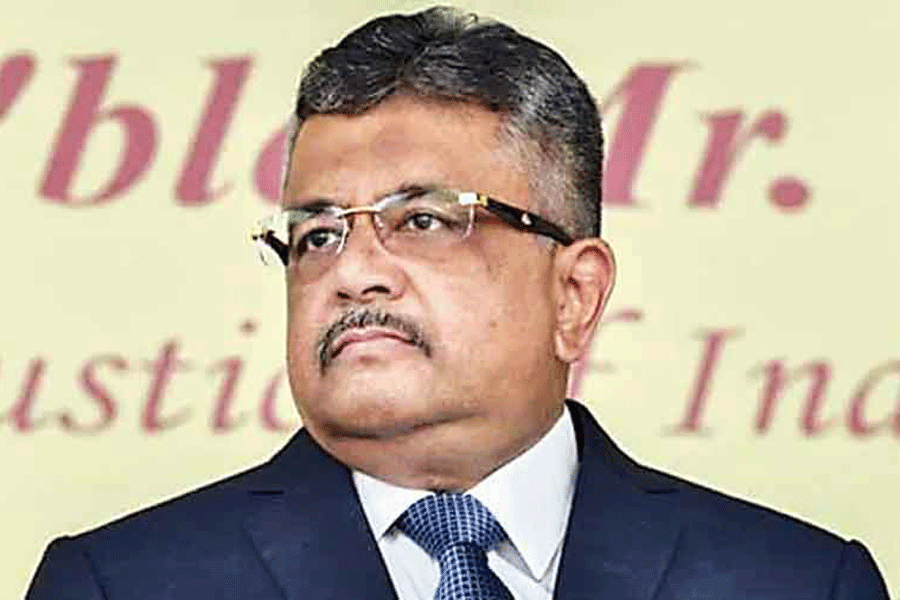The Centre on Wednesday recommended a standard operating procedure (SoP) that courts, including the Supreme Court, may follow while directing the personal appearance of government officials in their official capacity.
Solicitor-general of India Tushar Mehta told The Telegraph in response to a question: “These are suggested SoPs.” The reply implies they are not binding or mandatory.
“This SOP aims to create a more congenial and conducive environment between the judiciary and the government with a view to improve overall quality of compliance of judicial orders by the government, thereby minimising the scope for contempt of court,” says the new operating procedure.
The following are some of the procedures suggested:
Personal appearance: The following submission may be considered. The in-person appearance of government officials should be directed only in exceptional cases and not as a matter of routine. The courts should practice necessary restraint while summoning government officials, including in contempt cases.
When personal appearance is unavoidable, due notice, giving sufficient time for such appearance, must be served in advance to such official.
Even in the exceptional cases in which in-person appearance is mandatory, the court should allow video-conference as the first option. The invitation link can be sent by the registry to the given mobile number or email address of the official at least one day before the scheduled hearing.
The appearance of a government official in cases as pro forma party (not as a compulsory respondent) should be avoided. The same should apply to contempt proceedings too.
Comments on the dress/physical appearance/educational and social background of the government official should be avoided. Government officials are not officers of the court and there should be no objection to their appearance in decent work dress unless such appearance is unprofessional or unbecoming of her/his position.
Orders: Wherever the proceedings relate to an official/authority that has been conferred the status of a court, the court hearing the appeal must limit its determination to only the legality of the order. Facts already considered by the government official/authority need not be considered afresh by the court.
As the determination of an appeal is a mixed question of law and fact, the court hearing such appeal is open to examination of substantive facts that were not considered by such official/authority and refer the same back to the official with relevant directions. However, calling for personal appearance and/or frequent in-person attendance of such official before the court during regular hearing of the appeal is not necessitated in such a scenario and may be avoided by the presiding judge/judicial officer.
Contempt proceedings: It is already a settled position that for a contempt action to lie, it is necessary for the parent order to be an enforceable order. Therefore, compliance should not be insisted upon by court directing a particular outcome, especially on matters in the executive domain.
No contempt should be initiated in case of statements made in court by government counsel that is contrary to the stand of the government affirmed through its affidavit/written statement or reply submitted before the court. It is already established case law that an undertaking that is contrary to statutory provisions cannot be the basis for contempt proceedings. Similarly, in case of criminal contempt, the court should hesitate to punish a contemnor if the act or omission complained of was not wilful.
Before initiation of contempt proceedings, prayer for review petition on behalf of the government may be entertained by higher courts wherein it is prayed that substantive law points have not been considered by the court during adjudication of the matter.
In cases wherein a review petition has been admitted against a contempt order of a lower court, the lower court should take cognisance of the same and not initiate any related contempt proceedings in the instant matter. In cases wherein, contempt proceedings have already been initiated, the same may be directed to be kept in abeyance at the level of the lower court until the decision/outcome in review or appeal has been pronounced.
A judge should not, ideally, sit on contempt proceedings relating to their own orders.
Policy matters: If the issues are within the exclusive domain of executive and the same can be resolved only through an executive/administration-related decision, the court may refer the same to the executive for further necessary action.
In case of matters before court involving public policy having wider implication, exercise of caution is recommended to settle the point of law before pronouncing the decision on the individual representation.
If a committee need to be set up for further examination of the matter under consideration, the court may prescribe only the broad composition/domains of members/chairperson of such committee instead of naming individual members and leave the identification/selection/appointment of individual members/chairperson with the executive/administration.
Timelines: Compliance of judicial orders involving complex policy matters require various levels of decision-making and/or approvals. The court may take this into consideration before contemplating affixing some specific timelines for compliance of its orders.
If an order has already been passed and the time frame stated in the judicial order is requested to be revised on behalf of the government, the court may allow for a revised reasonable timeframe for compliance.











